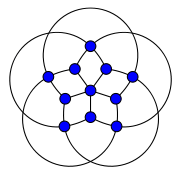Grötzsch graph
In the mathematical field of graph theory, the Grötzsch graph is a triangle-free graph with 11 vertices, 20 edges, chromatic number 4, and crossing number 5. It is named after German mathematician Herbert Grötzsch.
| Grötzsch graph | |
|---|---|
 | |
| Named after | Herbert Grötzsch |
| Vertices | 11 |
| Edges | 20 |
| Radius | 2 |
| Diameter | 2 |
| Girth | 4 |
| Automorphisms | 10 (D5) |
| Chromatic number | 4 |
| Chromatic index | 5 |
| Book thickness | 3 |
| Queue number | 2 |
| Properties | Hamiltonian Triangle-free |
| Table of graphs and parameters | |
The Grötzsch graph is a member of an infinite sequence of triangle-free graphs, each the Mycielskian of the previous graph in the sequence, starting from the null graph; this sequence of graphs was used by Mycielski (1955) to show that there exist triangle-free graphs with arbitrarily large chromatic number. Therefore, the Grötzsch graph is sometimes also called the Mycielski graph or the Mycielski–Grötzsch graph. Unlike later graphs in this sequence, the Grötzsch graph is the smallest triangle-free graph with its chromatic number (Chvátal 1974).
Properties
The full automorphism group of the Grötzsch graph is isomorphic to the dihedral group D5 of order 10, the group of symmetries of a regular pentagon, including both rotations and reflections.
The characteristic polynomial of the Grötzsch graph is
Applications
The existence of the Grötzsch graph demonstrates that the assumption of planarity is necessary in Grötzsch's theorem (Grötzsch 1959) that every triangle-free planar graph is 3-colorable.
Häggkvist (1981) used a modified version of the Grötzsch graph to disprove a conjecture of Paul Erdős and Miklos Simonovits (1973) on the chromatic number of triangle-free graphs with high degree. Häggkvist's modification consists of replacing each of the five degree-four vertices of the Grötzsch graph by a set of three vertices, replacing each of the five degree-three vertices of the Grötzsch graph by a set of two vertices, and replacing the remaining degree-five vertex of the Grötzsch graph by a set of four vertices. Two vertices in this expanded graph are connected by an edge if they correspond to vertices connected by an edge in the Grötzsch graph. The result of Häggkvist's construction is a 10-regular triangle-free graph with 29 vertices and chromatic number 4, disproving the conjecture that there is no 4-chromatic triangle-free n-vertex graph in which each vertex has more than n/3 neighbours.
Related graphs
The Grötzsch graph shares several properties with the Clebsch graph, a distance-transitive graph with 16 vertices and 40 edges: both the Grötzsch graph and the Clebsch graph are triangle-free and four-chromatic, and neither of them has any six-vertex induced paths. These properties are close to being enough to characterize these graphs: the Grötzsch graph is an induced subgraph of the Clebsch graph, and every triangle-free four-chromatic -free graph is likewise an induced subgraph of the Clebsch graph that in turn contains the Grötzsch graph as an induced subgraph (Randerath, Schiermeyer & Tewes 2002). The Chvátal graph is another small triangle-free 4-chromatic graph. However, unlike the Grötzsch graph and the Clebsch graph, the Chvátal graph has a six-vertex induced path.
References
- Chvátal, Vašek (1974), "The minimality of the Mycielski graph", Graphs and combinatorics (Proc. Capital Conf., George Washington Univ., Washington, D.C., 1973), Berlin: Lecture Notes in Mathematics, Vol. 406, Springer-Verlag, pp. 243–246, MR 0360330.
- Erdős, P.; Simonovits, M. (1973), "On a valence problem in extremal graph theory", Discrete Mathematics, 5 (4): 323–334, doi:10.1016/0012-365X(73)90126-X, MR 0342429.
- Grötzsch, Herbert (1959), "Zur Theorie der diskreten Gebilde, VII: Ein Dreifarbensatz für dreikreisfreie Netze auf der Kugel", Wiss. Z. Martin-Luther-U., Halle-Wittenberg, Math.-Nat. Reihe, 8: 109–120, MR 0116320.
- Häggkvist, R. (1981), Odd cycles of specified length in nonbipartite graphs, pp. 89–99, MR 0671908.
- Mycielski, Jan (1955), "Sur le coloriage des graphs", Colloq. Math., 3: 161–162, doi:10.4064/cm-3-2-161-162, MR 0069494.
- Randerath, Bert; Schiermeyer, Ingo; Tewes, Meike (2002), "Three-colourability and forbidden subgraphs. II. Polynomial algorithms", Discrete Mathematics, 251 (1–3): 137–153, doi:10.1016/S0012-365X(01)00335-1, MR 1904597.